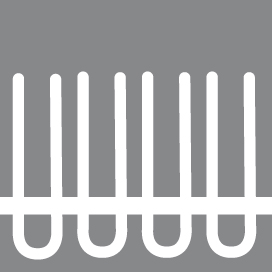Carpet tiles, also known as modular carpet, are a popular choice for flooring due to their ease of installation, durability, and versatility. They are made up of individual carpet squares or planks that are designed to be laid side by side to create a seamless carpeted surface. This modular approach allows for greater flexibility in design and easy replacement in the event of damage or stain.
Constructions
Carpet tiles offer a range of construction options for different flooring needs. Understanding the different constructions of carpet tiles can help you make the best choice for your space. Here are the three main carpet tile constructions to consider:
Loop Pile
Loop pile carpet tiles are made up of loops of carpet fibers that are tightly woven together to form a dense, low-profile surface. This construction is durable, easy to clean, and ideal for high-traffic areas. It is also often used in commercial spaces, as it can withstand heavy foot traffic without showing much wear and tear.
Multi-Level Loop Pile
Multi-level loop pile carpets are made up of high and low loops of two or more levels of loops, giving it a textured and patterned appearance. They are often used in high-traffic areas in commercial and residential spaces, as they are known for their durability and ease of maintenance.
Cut Pile
Cut pile carpet tiles are made up of cut fibers that create a plush, velvety surface. This construction is perfect for residential spaces, as it offers a warm, comfortable feel underfoot. Cut pile is available in a range of styles, including Saxony, Frieze, and Plush, making it a versatile option for any room in the home.
When choosing a carpet tile construction, consider the usage of the space, the level of foot traffic, and your personal style preferences. For example, if you're installing carpet tiles in a high-traffic commercial space, a loop pile construction might be the best choice for durability. On the other hand, if you're looking for a comfortable and stylish flooring option for your home, cut pile or patterned cut pile carpet tiles might be a better fit.
Understanding the different carpet tile constructions is important when choosing the right flooring option for your space. Whether you're looking for durability, comfort, or style, there is a carpet tile construction that will meet your needs.
Fiber Types
Carpet tile fibers will affect the appearance, durability, and performance of the flooring. Three of the most common carpet fibers used in homes are nylon, polyester, and polypropylene.
Nylon
Nylon is a strong, durable, and versatile fiber that is resistant to wear, staining, and fading. It is often used in high-traffic areas and is known for its soft feel and good resiliency. It is also the most recommended fiber type for commercial spaces.
Polyester
Polyester is a lightweight and soft fiber that is known for its bright and vivid color options. It is often used in low-traffic areas and is less durable than nylon. However, it is more stain-resistant and easier to clean than other fibers.
Polypropylene
Polypropylene, also known as olefin, is a synthetic fiber that is known for its resistance to moisture, stains, and mildew. It is often used in residential and light commercial carpet applications, and is less expensive than nylon and polyester.
In conclusion, each type of fiber has its own strengths and weaknesses, and the fiber you choose will depend on the location and use of the carpet, as well as your personal preferences and budget. Choose a high-quality fiber that will provide the performance and appearance you want for your home.
Advantages
Carpet tiles offer a range of advantages that make them a popular choice for both commercial and residential spaces. From ease of installation to versatility and affordability, carpet tiles offer a number of benefits that make them an excellent choice for your flooring needs. Here are some of the top advantages of carpet tiles:
Carpet tiles offer a range of advantages that make them an excellent choice for flooring. Whether you're looking for ease of installation, versatility, affordability, durability, or eco-friendliness, carpet tiles are a great option for your flooring needs.
Installation tips
Before installation, all other remodeling intended in the room should be completed, such as painting or wallpapering. Check the clearance at the bottom of doors to be sure they will swing freely over the new carpet tiles. If the doors do not clear, arrange to have them trimmed. Most installers will not be able to do this for you.
Make sure your carpet tiles or planks come from the same batch before installing them. It’s important because this may cause inconsistencies.
Lay the carpet tiles or planks in the room you are looking into redoing and let them acclimate to the room temperature for 48 hours.
Check which adhesives are recommended for your product and make sure to match it.
Be sure to ask the retailer about additional services such as removal and disposal of older flooring and moving furniture. (Additional fees may apply).
Various installations can be done with tiles and planks and that’s what makes them so fun!
Installation Methods
Monolithic
This pattern definition is the most traditional. All tiles must face the same way. That’s what creates the pattern in its true impression.
Quarter-turn
The quarter-turn pattern creates a circular movement because like the name states, each tile is turned 90o clockwise to show a different design.
Random
As crazy as it sounds, a random installation is a technique that allows the tiles to be oriented in any direction, creating an eclectic yet playful look.
Brick
A brick installation has to do with lining all tiles the same way but bricking them to create a linear and controlled pattern. Just like a brick wall!
Ashlar
This installation creates movement in a vertical way. In fact, similarly to the brick pattern, you’ll fix two tiles one over the other, then create your linear pattern by offsetting the next line of tiles on the right at a different height.
Herringbone
This installation creates movement in a vertical way. In fact, similarly to the brick pattern, you’ll fix two tiles one over the other, then create your linear pattern by offsetting the next line of tiles on the right at a different height.
Care and Maintenance
There are four simple tips to keep your carpet tiles beautiful.
Use entrance mats
Place walk-off mats inside and outside entrances to your home to trap soil before it can be tracked in. Be sure to clean mats weekly to ensure they don’t become soil sources. Avoid latex-backed runners which may yellow the carpet.
Vacuum regularly
Regular, thorough vacuuming will remove dust and gritty dirt particles and reduce the abrasion that can dull and wear carpet fibers. A rotating brush power-head vacuum raises the carpet pile while it removes the soil. Change the vacuum bag often. To reduce matting, change the direction of vacuuming occasionally.*
Clean up spills immediately
Prompt attention to spots and spills will make removal easier. Always blot the area being cleaned, never rub, scrub or brush.
Schedule professional cleanings
Choose a qualified cleaning service, experienced in the latest techniques for advanced generation fibers and have your carpet professionally cleaned every 12-18 months (keep all receipts for proof of cleaning). High traffic areas and lighter carpet colors may require cleaning more often. Hot water extraction is the preferred method, using products which are non-cationic and have a pH level less than 10. Non-approved cleaning products or treatments will void your warranty.
* Attention: some vacuums have aggressive brushes that may damage the pile surface. Refer to the Carpet and Rug InstituteTM for approved vacuum cleaners and details.
Warranty
Beaulieu Canada offers great warranties so you have peace of mind after your purchase. Flooring is made for living and we understand that. In order to benefit from our warranties, take note of what you need to do as a consumer by reading the complete carpet warranty guide.







